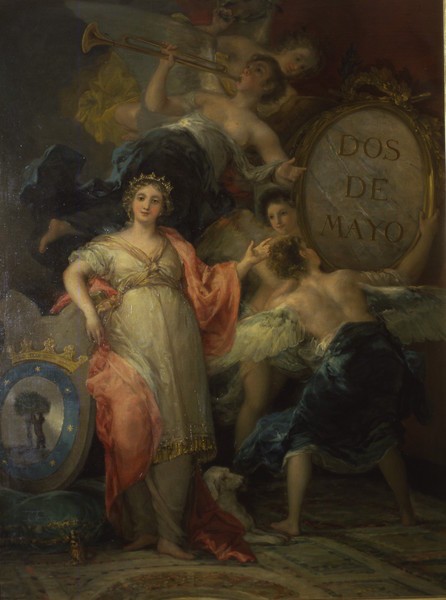- Cronología
- 1810
- Ubicación
- Madrid History Museum, Madrid, Spain
- Dimensiones
- 260 x 195 cm
- Técnica y soporte
- Oil on canvas
- Reconocimiento de la autoría de Goya
- Documented work
- Titular
- Madrid City Hall
- Ficha: realización/revisión
- 03 Apr 2010 / 14 Jun 2023
- Inventario
- (35.352)
In 1809 the council of the City of Madrid proposed the commissioning of a portrait of the new French monarch of Spain, Joseph I. Tadeo Bravo de Rivero, who was in charge of the project, commissioned Goya to paint the work in February 1810. According to Bravo de Rivero's reports to authorities, the artist could not accept a fee of less than 15,000 reales, suggesting that this is the amount that he was paid for his work.
The painting has always remained in the possession of the municipal government of Madrid.
As source materials for this royal portrait, Goya had only a print depicting the King's face produced in Rome. The lack of a model led him to design an intelligent composition based on an allegory of the city. A woman of harmonious proportions wearing a crown, a white tunic, and a pinkish mantle leans against a shield carrying the coat of arms of the city of Madrid. She is pointing to a majestic oval where the artist painted the face of Joseph I. Two angels hold the portrait of the monarch, while another two winged figures representing Fame and Victory fly above, accompanied by their respective attributes - a trumpet and a laurel crown. The artist's allegorical scheme is completed by a dog signifying loyalty, which is discreetly hidden behind the woman representing Madrid.
Historical events led to the painting being altered on various occasions in order to adapt it to the political tide of the times. Thus, following Wellington's victory at the Battle of Salamanca, Joseph I fled the city, and Goya hastened to paint over the Frenchman's face with the slogan "Constitución" ("Constitution"). When Napoleon's brother returned in November, Felipe Abas - one of Goya's disciples - eliminated his master's repainting to recover the figure of Joseph Bonaparte, as evidenced by the letter sent by Goya to the Secretary of the city of Madrid informing him of the events. The definitive victory over the French in 1813 led to another change to the oval, where Dionisio Gómez, another of Goya's disciples, wrote the motto "Constitución" once again. The story continued when Ferdinand VII returned to Spain and ordered the abolition of the Cádiz Cortes, which meant that Goya had to substitute the writing with a portrait of Ferdinand "the Desired". The result was not up to scratch, most likely because he commissioned the work to one of his collaborators. In 1826, taking advantage of Goya's absence (he had moved to Bordeaux), the royal portrait was repainted by Vicente López. Ten years after the death of Ferdinand VII, the city of Madrid requested the covering of the portrait with the inscription "Libro de la Constitución" ("Book of the Constitution") until in 1872 it was definitively replaced with the phrase "Dos de mayo" ("Second of May") which we see today. Interestingly, this last lettering is a homage to the day when the Spanish rose up against the French invaders led by Bonaparte, the first occupant of the frequently altered oval.
-
Goya 1900Ministerio de Instrucción Pública and Bellas ArtesMadrid1900consultant editors Aureliano de Beruete, Alejandro Ferrant, Marqués de Pidal and Ricardo Velázquez. May 1900cat. 21
-
Exposición histórico-artística del Centenario del Dos de MayoMuseo Arqueológico NacionalMadrid1908cat. 256
-
Pinturas de GoyaMuseo Nacional del PradoMadrid1928consultant editor Fernando Álvarez de Sotomayor. From Apri to -May 1928cat. 56
-
GoyaFestival Internacional de Granada, Palacio de Carlos VGranada1955consultant editor Enrique Lafuente Ferraricat. 108
-
De Tiépolo à GoyaGalerie des Beaux-ArtsBurdeos1956consultant editor Gilberte Martin-Méry. From May 7th to July 31st 1956cat. 122
-
Francisco de Goya. IV Centenario de la capitalidadorganized by Ayuntamiento de Madrid and Dirección General de Bellas Artes at the Casón del Buen RetiroMadrid1961consultant editor Valentín de Sambriciocat. I
-
cat. 69
-
Goya and his timesThe Royal Academy of ArtsLondon1963cat. 66cat. 96
-
Madrid testimonios de su historia: hasta 1875Museo MunicipalValencia1979from December 1979 to February 1780cat. I-155
-
Goya y la Constitución de 1812Museo Municipal de MadridMadrid1982organized by Madrid Town Hall, consultant editor José Manuel Pita Andrade. From December 1982 to January 1983cat. 3
-
Goya en las colecciones madrileñasMuseo Nacional del PradoMadrid1983consultant editor Enrique Lafuente Ferrari. From April 19th to June 20th 1983cat. 37
-
La alianza de dos monarquías: Wellington en EspañaMuseo MunicipalMadrid1988organized by Fundación Hispano-Británica in collaboration with Ayuntamiento de Madrid. From October 19th to December 11th 1988cat. 1.6.9.
-
Goya (1746 – 1828)Galleria Internazionale d’Arte Moderna di Ca’PesaroVenecia1989consultant editor Antonio Fortún Paesa. From May 7th to July 4th 1989cat. 38
-
GoyaNationalmuseumStockholm1994consultant editors Juan J. Luna and Görel Cavalli-Björkman. From October 7th 1994 to January 8th 1995cat. 37
-
Goya. La imagen de la mujerMuseo Nacional del PradoMadrid2001from October 30th 2001 to February 10th 2002. Exhibitied also at the National Gallery of Art, Washington, March 10th to June 2nd 2002, consultant editor Francisco Calvo Serrallercat. 54
-
Zaragoza2021
-
L'œuvre peint de Goya. 4 volsParís1928-1950vol. I, p. 140, cat. 97
-
Vie et ouvre de Francisco de GoyaParísOffice du livre1970pp. 253, 261, cat. 874
-
BarcelonaPolígrafa1970vol. I, p. 343, cat. 555
-
L’opera pittorica completa di GoyaMilanRizzoli1974p. 123, cat. 509
-
DiplomatarioZaragozaInstitución Fernando el Católico1981p. 367, nºs 237-238
-
Goya, la imagen de la mujerMadridMuseo Nacional del Prado y Fundación Amigos del Museo del Prado2001pp. 228, 335, cat. 54 y p. 229 (il.)
-
Goya. Traveler and artist of the Grand Tour (exp. cat.)ZaragozaGobierno de Aragón2021pp.220-221
